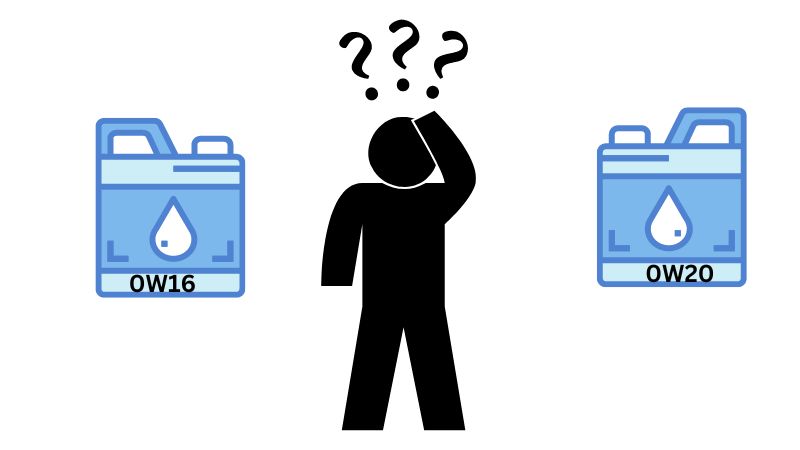Both 0w20 and 0w16 oils are low viscosity oils and highly fuel efficient. These lighter-viscosity oils are best suited for modern engines with low-viscosity oils. In addition, 0w16 Oil performs very well in extremely cold temperatures and delivers instant flow. Actually, they provide the same viscosity.
That’s why most people ask the question: What’s the critical difference between 0w16 vs 0w20? Knowing how 0w16 differs from 0w20 will help you choose the best Oil for your vehicle. Here we will discuss in detail so you can clearly understand both oils.

What Is 0W16 Oil?
Accordingly, 0w16 engine oil provides increased fuel economy. Low-viscosity oils, including 0w16, have been used in Japan since the 1990s (ref). So, though it may seem unusual, it’s only likely to become more common in North America. And already North American Honda and Toyota vehicles use this 0w16 Oil.
Lower viscosity oil delivers less resistance to moving parts within the vehicle. It also means that lower viscosity increases engine wear. Design engineers have approved this Oil for engines suitable for 0w16 motor oil based on the tight tolerances. And they determine that it’s safe for cars.
Another benefit of using a ‘thin’ oil is it can reduce the engine warm-up time, although this effect may be minimal. All 0w16 engine oils are synthetic.
What Is 0w20 Oil?
0W20 is a grade of motor oil, and it comes with a particular viscosity and semi-fluid properties. These properties are necessary to keep your engine running smoothly in any condition.
Motor oils graded with the 0W20 specification can tolerate harsh conditions. And also can maintain flow continuity without causing any friction inside your engine.
To simplify things, let’s break down what 0w20 means:
When the engine is cold, the ‘0’ before the ‘W’ refers to oil viscosity or semi-fluid properties. Here ‘W’ refers to the winter season, and ’20’ is associated with the Oil’s semi-liquid properties at high temperatures. Note that the lower the number, the thinner the motor oil viscosity.
How Is 0w16 Oil Different Than 0w20 Oil?
When the Oil is hot and your engine is at average temperatures, 0w16 Oil is slightly thinner than 0w20. Sometimes 0w16 Oil is lighter than 0w20 when the Oil is cold. p Besides this, it also performs amazingly in heat exchange because 0w16 will flow very quickly and easily. Yet, 0w20 is known as fuel efficient, but 0w16 is more energy efficient Oil.
Usually, you can use 0w16 in engines where 0w16 is required or recommended. But you will use 0w20 in machines that recommend 0w16, which won’t cause any short-term harm. It’s always best to use the manufacturer’s recommended oils.
If your vehicle needs to use 0w20 or 5w20, you can’t use 0w16. Diluting with the second number can wear out your bearings prematurely. Thinner oils can’t stop engine high-speed moving components as well as thicker oils.
The job of oils is to protect metal parts from touching. If this oil garment meets the bearing clearance spec, your bearing will be fine. However, in America, the only GF-6 B-certified oil is 0w16. GF-6A is all other oils, from 0w20 to 10w30.
Compare To 0w16 Vs 0w20 Oil:
0w16 Vs. 0w20 Oil viscosity performs excellently in the cold and offers instant circulation through your engine. However, we will compare both oils here based on a few factors, so keep in touch.
Viscosity:
Sixteen out of 0W16 indicate the Oil’s viscosity characteristics when the Oil is at a high temperature. Higher viscosity oil is suitable to drive at high speeds or under extreme loads.”
Unfortunately, 0w16 is a low-viscosity oil and recently entered the U.S. for the first time. This Oil is fitted with the 2018 Honda Fit and 2018 Toyota Camry 2.5L Four-Cylinder models.
SAE 0W16 and 0w20 oil may provide extra fuel economy benefits compared to higher-viscosity oils; Japanese car owners have used them for a long time.
Application:
0w16 and 0w20 viscosity oils suit modern petroleum engines, especially in cold regions. They both come with higher fuel economy.
Japanese car manufacturers are recommending this thinner Oil for use in their cars. Nonetheless, with global demand for fuel economy increasing, more European automobiles will soon begin recommending 0w20 and 0w16.
Price Range:
0w16 is more expensive than 0w20 Oil. Between 0w-16 and 0w-20 viscosity oils, 0w16 is more costly. The Oil is very thin, making it excellent for fuel efficiency. However, light Oil can’t properly lubricate the engine’s moving parts.
Therefore, thinner oils are formulated to provide maximum fuel efficiency and safety. Currently, 0w16 is too thin and requires chemicals to protect the engine. That’s why it is more expensive than 0w20.
0w16 Oil Vs 0w20 Toyota:
Toyota manufacturer used 0w20 even though the 0w16 offers the best viscosity. It’s okay to use 0w20, but using thinner consistency is better whenever possible. A 2% improvement in fuel economy is claimed by changing from 0w20 to 0w16.
Toyota dealers used 0w16 Oil for their cars. But other non-brand garages typically use 5w30 Oil. And if you want, you can see this Oil if you have an emergency.
0W16 is the Oil of choice for Toyota. Under the block exemption, Toyota cannot force dealers to use a specific oil, so there is some variation between options.
The best way around this is to specify the 0W16 Oil used when booking the service. And while taking the car in service check, it will be used.
0w16 Oil Vs 0w20 Mercedes:
For your Mercedes 0w16, Oil isn’t suitable to use. Likewise, 0w20 advanced full synthetic motor oils approved against Mercedes. Without 0w20, you can use 0w30, 0w40, 5w40, and 5w50 viscosity oil in your Mercedez.
0w16 Vs 5w20:
SAE 0W16, API SP, ILSAC GF-6B is a fully synthetic motor oil formulated to use in modern gasoline engines. Modern engines require ILSAC GF-6B, API SN Plus, or API SN performance 0W16, and viscosity grade at 16.
Synthetic base oil and premium additive package protects high-compression gasoline direct injection engines. It provides exceptional oxidative strength, deposit control, and timing chain wear protection.
In contrast, 5W20 Oil can flow decently at low temperatures yet provide protection when it warms up. Additionally, this Oil provides good cold-start performance and offers summer protection. Five refers to lower viscosity at lower temperatures. Thus, 20 is the Oil’s viscosity rating during hot temperatures.

FAQ (Frequently Asked Questions):
Q. Can I use 0w16 instead of 0w20?
It’s recommended to use 0w16 where you need 0w16. But if 0w16 Oil isn’t available, you can use 0w20. Generally, 0W16 Oil contains an extra advanced additive package and anti-wear protection. Slight differences in viscosity will not be a problem.
Read Also: Can I use 0W20 instead of 5W20?
Q. Can I use 5W-20 instead of 0W16?
SAE 0W16 motor oil is exceptional. 0W16 grade oils are specifically designed for engines that require this viscosity grade. Ergo, it’s not suitable for 5W20 thicker oil grades.
Q. Who makes Toyota 0w16 Oil?
The best 0W16 motor oil is genuine Toyota oil which is available. With Toyota specifications, this 0w16 Oil is made by Mobil 1. Toyota’s motivation is vehicle longevity and fuel efficiency. The oil manufacturers’ motivation is to fulfill specifications and save costs.
Final Word:
You may now know the difference between 0w16 Oil vs. 0w20 Oil. Both are low-viscosity and thinner oils and will become engine lubricants future. Although 0w16 and 0w20 maximize engine fuel efficiency and have other benefits, please use them with weather knowledge.
The Oil is unsuitable for your car and can seriously damage your engine. This Oil is inferior at properly lubricating engine parts at high temperatures.

